Harvey dumped an unprecedented amount of rain across the Houston metropolitan area and the flooding was widespread. Some of the hardest hit areas, like Memorial, gained ongoing media attention. The curfew in place in that neighborhood was only lifted Friday, 10 days after the citywide curfew had been lifted. But understanding which of the neighborhoods turned inside out, households' now toxic contents piled on the street, are facing the most flood damage has been tough.
Using data from the Federal Emergency Management Agency that estimates which homes could be expected to flood given the rainfall between August 27 and September 2, an analysis by the Kinder Institute found that roughly 29 percent of Houston's parcels with some sort of housing on them and 9 percent of Harris County's parcels with housing on them were likely affected by flooding. Those numbers are conservative since a given parcel could have multiple units on it, as in the case of an apartment building. Notably, that estimate also does not include elevated structures that may have avoided floodwaters or account for wind damage, flooding from dam or levee breaks, flooding as a result of failure of irrigation ditches, use of spillways and weirs, small tributary flooding with minimal or no gauge data or storm water backup.
With the third storm in as many years surpassing the 100-year flood mark, Houston neighborhoods not used to flooding are quickly getting familiar with it.
In Harris County, roughly 27 percent of the homes expected to be damaged from flooding during Harvey, considered a 500-year flood, were within the 100-year floodplain, according to the analysis by Jie Wu, director of research management, and research analyst Mingming Zhang. Another 27 percent fell within the 500-year floodplain. With just around 5 percent of the likely flood-affected falling inside the floodway, a total of roughly 41 percent of the homes in Harris County likely to have experienced flooding were outside the floodway, 100-year floodplain and 500-year floodplain.
Meanwhile in Houston, roughly 37 percent of the homes expected to be affected were within the 100-year floodplain, with another 26 percent falling within the 500-year floodplain and roughly 8 percent within the floodway. Just under a third - roughly 30 percent - were outside all three of those geographies.
Using 143 community tabulated areas in Harris County, the researchers found the 10 neighborhoods with the most flooded homes, according to the estimates using FEMA data, as well as the estimated number of homes likely to have been flooded in each of those neighborhoods.
Though the recovery will look very different for different communities and will undoubtedly exacerbate disparities, the flooding disproportionately impacted white, middle class and upper class communities in the city of Houston, according to the analysis.
It's worth noting, however, that overall, households earning under $25,000 annually still made up the largest groups of those likely affected at roughly 23 percent. And the second largest group was households earning between $25,000 and $49,999.
The analysis also revealed that in Houston, more renters than homeowners were affected, comprising roughly half of all units expected to be impacted, while owner-occupied households only represented around 38 percent of units affected. The rest were vacant.
In Harris County, however, the two populations were more or less equally affected, with owner-occupied units representing 46 percent and renter-occupied units representing 43 percent of the units likely to be affected. The remaining impacted units were vacant, according to the analysis.
Some renters are facing eviction. Meanwhile, many home-owners are struggling as well.
"While many of the communities with the highest amounts of accumulated housing equity were spared, many homeowners who were just beginning to build housing equity were hit hard," write Sarah Strochak and Bhargavi Ganesh for the Urban Institute as part of an analysis of flooding in the larger Houston metropolitan area. "We may see borrowers who had just a small amount of equity slip into negative equity, as home values drop. For homes that were destroyed or are uninhabitable, or where the homeowner cannot afford to rebuild, equity will be entirely lost."
According to the Urban Institute analysis, many of the areas hardest hit had high concentrations of Federal Housing Administration insured loans, which help low- and moderate-income folks by allowing flexibility on many of the upfront costs of buying a home, but requiring the purchase of extra insurance. "This will be a test for the mortgage insurance fund and for FHA loan and loss-mitigation programs," the authors conclude.

